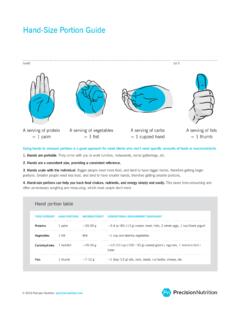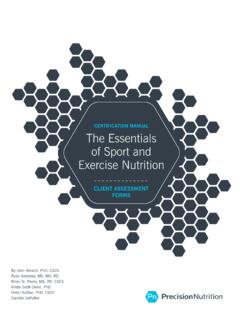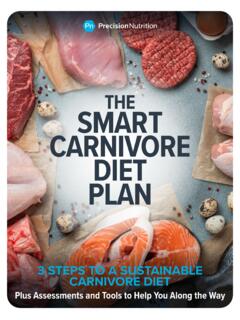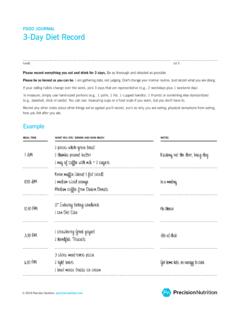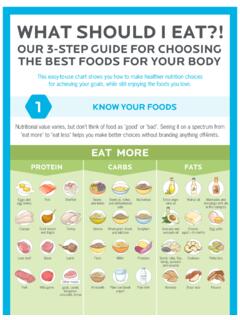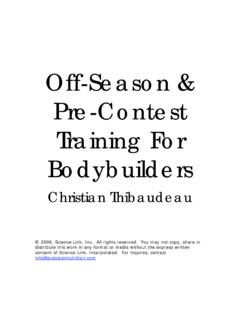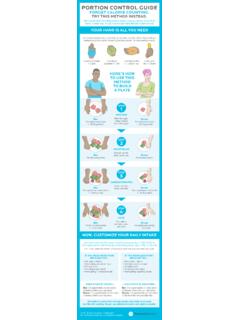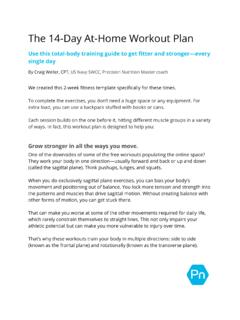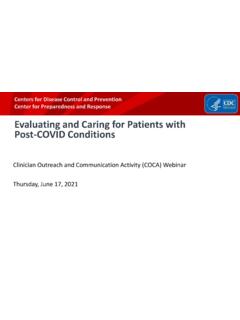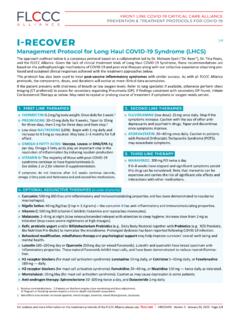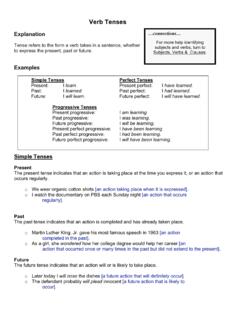Transcription of The Get Shredded Diet By Dr John Berardi, CSCS
1 The Get Shredded diet By Dr john Berardi, CSCS A Warning First things first; the dietary strategy outlined below is extreme. In fact, the dietary strategy outlined below is so extreme that you ll likely have to alter many of your lifestyle habits even those independent of exercise, nutrition, and supplementation just to tough through it. It s that hard. It s that extreme. However, in the case of the dietary strategy discussed below, extreme isn t synonymous with dangerous. In fact, if applied strategically and infrequently, this strategy might even improve your health. And that s why I use it myself once every 2 years for about 6-12 weeks to improve my health while getting pretty scary-lean. I ll say that again I use it ONCE every 104 weeks for ONLY 6-12 weeks and I use it in between long periods of healthy eating, sound training, and smart supplementation. Those of you who follow my writing know that my baseline nutrition approach is best known for being moderate, smart, and sound.
2 And that s why 92-98 out of 104 weeks are marked by moderation and good dietary decision making. But that s not what this article is about. No, this article is about presenting an extreme dietary strategy designed to make body fat disappear into thin air in the shortest amount of time. To give you an idea of just how fast we re talking you should expect % body fat decreases of about per week when following the Get Shredded diet . No kidding. And with this rate of progress, you ll actually be seeing physical changes every few days. The Get Shredded diet Isn t For Everyone Now, I can t emphasize this point enough - this strategy isn t for everyone. In fact, if you re closer to 20% body fat than you are to 10%, this strategy isn t for you at all. Instead, just like Dave Tate (below), and many clients before him, if you re starting out close to 20% fat (or more), you need to pick up a copy of my Precision Nutrition kit and start there. Precision Nutrition will give you the foundation you absolutely need if you want to walk around with a respectable level of body fat year-round.
3 Dave Tate Before - 18-20% bodyfat This physique was accomplished with lots of hard, heavy lifting but really poor food choices Dave Tate After - 8-10% bodyfat This physique was accomplished with lots of hard and heavy training and very smart food choices (no extreme dieting here). If you want to learn the system that Dave used to make this transformation, check out Precision Nutrition. However, once you have figured out how to slowly and sanely whittle your fat percentage down to the fairly lean range (12% or less for men and 19% or less for women) and you ve learned the habits that help you stay that way, that s when something like The Get Shredded diet can be a powerful weapon in your fat loss Simply put, if you re starting out fairly lean, you follow the Get Shredded diet strictly, you have no underlying clinical problems, and you begin from a good foundation of eating, supplementing, and training properly, The Get Shredded diet will make your body fat appear as if it s disappearing before your very eyes.
4 The Strategy Below you ll find the Get Shredded diet . I ll lay out the full plan the calories, the macronutrient breakdowns, the meal breakdowns, the example menu, the re-feed days, the supplements, and more. Heck, I ll even talk about why on earth one might want to get down to 3 or 6% body fat even if they re not a physique competitor. (You might be surprised). So get out your pens and pencils and start taking notes. The Calories: To goal of The Get Shredded diet is to help you drop -1% body fat per week for between 6 and 12 weeks (the duration depends on how much fat you have to lose and how long you want to endure the plan). With this goal in mind, you know you re gonna have to cut calories. And you re gonna have to cut them hard. So here s your new calorie formula: Body weight in lbs x 10kcal Now, does it have to be exactly bodyweight x 10 every day? Not necessarily. Your calorie intake will likely fluctuate unless you eat the same exact things every day.
5 So, if it fluctuates naturally, don t worry if you re at bodyweight x 9 one day and bodyweight x 11 another day. You can likely get away with that 10% spread. However, just make sure you stick within this range of calories and don t try to justify taking in more! For you mathematically challenged, here s a handy little table that outlines how many calories you should be aiming for. Bodyweight* Calorie Intake 100 lbs 1000kcal (900-1100) 150 lbs 1500kcal (1350-1650) 200 lbs 2000kcal (1800-2200) 250 lbs 2500kcal (2250-2750) 300 lbs 3000kcal (2700-3300) *Of course, if you re in between these weights, do your own calcs, they re pretty simple. It s justbody weight x this point a couple of important notes on calories: 1) If you re one of the folks discussed above that naturally fluctuate in their day-to-day intake and you re not seeing the per week fat loss rate, youabsolutely have to do two things. First, make sure you tighten things up and areconsistent day-to-day.
6 Second, make sure to stick to the lower end of the range(bodyweight x 9). Heck, some of you might even need to try to bodyweight x 8,if necessary. But start at the 9-11 range and measure your results every week todetermine how to change up the ) If you ve been chronically undereating for a long period of time, this programwon t work as well for you. As discussed above, those individuals who vefigured out how to stay fairly lean while choosing balanced meal selections will do best when the launch into The Get Shredded diet . So, if you re a chronicundereater, you ll likely need to repair your metabolic rate and hormonal profilebefore starting this diet . Again, Precision Nutrition can teach you Macronutrient Split: Ok, now that we ve established the right calorie range and the conditions necessary before starting the Get Shredded diet , let s talk macronutrients. Protein should make up between 30 and 35% of your daily intake and all of it should come from whole food sources.
7 This is the case for 3 reasons: 1) Whole food sources will contain more vitamins and minerals and it sessential to maximize vitamin and mineral intake when on such a lowcalorie diet . With this level of hypocaloric intake, you ll already beborderline deficient in some micronutrients so don t make it worse byusing low micronutrient proteins during this extreme hypocaloric ) Whole food sources provide better satiety vs. most supplementalprotein sources. As you re going to be huuuungry, you ll need every bitof satiety you can ) Whole food sources have a higher thermic effect vs. most supplementalprotein sources. Since you ll want to maximize your metabolic rate duringthe Get Shredded diet , you ll want to increase your thermic should make up 10-15% of your intake. All of your carbohydrates on The Get Shredded diet should come from fresh vegetable sources (preferably organic) like spinach, broccholi, green beans, asparagus, zucchini, cauliflower, different color peppers, carrots, tomatoes, etc.
8 Again, right now you ll need all the nutrition you can get in as few calories as possible. The veggies listed above fit the bill beautifully. Every day I d like you to get at least one serving (1/2 cup) of each of the veggies listed above. Fats should make up 55-60% of your intake. You should be getting a fairly even mixture of saturates, polyunsaturates, and monounsaturates (this means about 33% of your total fat coming from each). But don t worry, you don t have to be exact. Simply adding some olive oil, flax oil, fish oil, and avocado each day will help. Now, at this point, I want to share with you another handy chart that now includes your protein, carb, and fat intake goals: Bodyweight Calorie Intake Protein Intake Carb Intake Fat Intake 100 lbs 1000kcal 75g 25g 66g 150 lbs 1500kcal 113g 38g 100g 200 lbs 2000kcal 150g 50g 132g 250 lbs 2500kcal 188g 63g 167g 300 lbs 3000kcal 226g 76g 200g *Of course, if you re in between these weights, do your own calcs, they re pretty simple Meal Timing: Now that we ve established your calorie, protein, carb, and fat goals, let s talk meal breakdowns.
9 Fortunately, this part is simple. You re going to eat 4 food meals each day with your calories evenly split throughout the day. So, simply divide the numbers above by 4 to get your per-meal totals. Again, another chart to ballpark your meal-by-meal goals: Bodyweight Calorie Intake/MealProtein Intake/MealCarb Intake/MealFat Intake/Meal 100 lbs 250kcal 19g 7g 17g 150 lbs 375kcal 28g 10g 25g 200 lbs 500kcal 38g 13g 33g 250 lbs 625kcal 47g 16g 42g 300 lbs 750kcal 57g 19g 50g *Of course, if you re in between these weights, do your own calcs, they re pretty simple Now, does each meal need to be exactly 1/4th of the daily total. No! Just make sure that you re splitting your food intake up relatively evenly throughout the day and you ll be fine. The Supplements: Now, after reading the calorie ranges and macronutrient breakdowns above, you re probably ready to give the local loony-bin a shout. You might be thinking that I m outta my mind. Perhaps you re worried about muscle and strength loss.
10 Perhaps you re thinking that you ll suffer poor brain function with that few carbohydrates. Perhaps you re worried about nutrient deficiencies. Or you might have one of a host of other maladies in mind. Well, worry no longer. If you use the following supplement strategy, you ll be filling in your nutritional gaps, you ll be making sure to avoid as much brain fog as possible and you ll be preserving muscle mass quite well. And this isn t just theoretical. I ve done the nutritional analyses; have used this protocol repeatedly with myself and other clients; and promise that if you do exactly what I say, you ll have the best experience possible although, again, this won t be easy. Nor does this mean that you won t lose an ounce of muscle or won t lose any strength. What it does mean is that my suggestions will help mitigate the muscle and strength losses, minimizing them. So here s what to do: Supplements #1 and #2 Branched Chain Amino Acids and Creatine Think of these two supplements as your muscle mass saviors.
